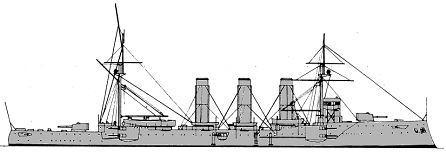
NAVYPEDIA
 Support the project with paypal
Support the project with paypal
Photo

Cumberland as built
Ships
| Name | No | Yard No | Builder | Laid down | Launched | Comp | Fate |
|---|---|---|---|---|---|---|---|
| Kent | P27, P80, P99 | Portsmouth DYd | 12.2.1900 | 6.3.1901 | 1.10.1903 | sold 6.1920 | |
| Essex | 51, 62 | 236 | Pembroke DYd | 1.1.1900 | 29.8.1901 | 22.3.1904 | sold 11.1921 |
| Bedford | 414 | Fairfield, Govan | 19.2.1900 | 31.8.1901 | 11.11.1903 | wrecked 21.8.1910 | |
| Monmouth | D28 | 304 | London & Glasgow, Glasgow | 29.8.1899 | 13.11.1901 | 2.12.1903 | sunk 1.11.1914 |
| Lancaster | 71, 78 | 714 | Armstrong, Elswick | 4.3.1901 | 22.3.1902 | 5.4.1904 | sold 3.1920 |
| Donegal | 9C, 55 | 417 | Fairfield, Govan | 14.2.1901 | 4.9.1902 | 5.11.1903 | sold 7.1920 |
| Berwick | 36, P74, P08 | 474 | Beardmore, Dalmuir | 19.4.1901 | 20.9.1902 | 9.12.1903 | sold 7.1920 |
| Cornwall | D31, P04, P84 | 237 | Pembroke DYd | 11.3.1901 | 29.10.1902 | 1.12.1904 | TS 1919, sold 6.1920 |
| Cumberland | D37, P76, P86 | 312 | London & Glasgow, Glasgow | 19.2.1901 | 16.12.1902 | 1.12.1904 | sold 5.1921 |
| Suffolk | 20, P87, PA5 | Portsmouth DYd | 25.3.1901 | 15.1.1903 | 21.5.1904 | TS 1919, sold 7.1920 |
Technical data
| Displacement normal, t | 9800 |
|---|---|
| Displacement full, t |
|
| Length, m | 134.1 pp 141.3 oa |
| Breadth, m | 20.1 |
| Draught, m | 7.62 |
| No of shafts | 2 |
| Machinery | Kent, Essex, Bedford, Monmouth, Lancaster, Donegal, Cumberland: 2 4-cyl VTE, 31 Belleville boilers Berwick, Suffolk: 2 4-cyl VTE, 31 Niclausse boilers Cornwall: 2 4-cyl VTE, 31 Babcock boilers |
| Power, h. p. | 22000 |
| Max speed, kts | 23 |
| Fuel, t | coal 1600 |
| Endurance, nm(kts) | 2740(24) |
| Armour, mm | belt: 102 - 51, bulkhead: 127, decks: 51 - 19, turrets: 127, barbettes: 127, casemates: 102 - 51, ammunition hoists: 51, CT: 254 |
| Armament | 2 x 2 - 152/45 BL Mk VIII, 10 x 1 - 152/45 BL Mk VII, 10 x 1 - 76/40 12pdr 12cwt QF Mk I, 3 x 1 - 47/40 3pdr Hotchkiss Mk I, 2 - 450 TT (sub, beam) |
| Complement | 678 |
Standard scale images

Kent 1905
Graphics
Project history
The Monmouth class was built in answer to a general increase in armoured cruiser construction in foreign navies, Kent and Essex being provided under a supplementary estimate to the 1898/99 Programme, Bedford and Monmouth under the 1899/1900 Programme and the remainder under the 1900/01 Programme. The ships represented an attempt to provide first class cruisers of equal speed to the Drake class but of smaller size so that they would be cheaper to build and operate, more economic on manpower and could be built in larger numbers. This object was achieved by substantial reductions in both armour and armament, enabling the displacement to be bought down to 9800t. However they were heavily criticised for these reductions in fighting power and were regarded by many as second rate ships which could not adequately fulfil the functions for which they had been designed. Four of the 152mm guns were mounted in twin turrets on the forecastle and quarterdeck while the remainder were mounted in two-storey casemates abreast the fore- and mainmasts and in single casemates on each side amidships. The turrets were electrically operated and promised to be one of the best features of the design but the electrical gear proved to be unreliable, the gunhouses too cramped for efficient operation and the guns difficult to align due to their being fitted in a single cradle. All exceeded the designed power on trials, but three, Essex, Monmouth and Kent were accepted at slightly less than the design speed. Lancaster and Suffolk, however, made 24 and 24.7kts respectively at full power, while the remainder averaged 23.6kts. In general they were good steamers and seaboats but they had very fine lines fore and aft which, combined with the weight of the turrets, tended to cause heavy pitching in rough weather.
Ship protection
The arrangement of armour was the same as that in Cressy but of generally reduced thickness. The main 102mm belt was 73.8m long by 3.5m deep amidships and was continued to the stem by 51mm thick side armour. The protective deck was 64mm thick abaft the armoured bulkhead and 19mm for the length of the belt, while the main deck was 32mm for the length of the belt.
Modernizations
1917, Berwick, Cornwall, Essex, Kent, Lancaster: - 6 x 1 - 152/45 (in lower casemates); + 4 x 1 - 152/45 BL Mk VII (in shields on the shelter deck)
Naval service
Bedford wrecked at Quelpart Island in the China Sea 21.8.1910, wreck was sold for BU in October. Cornwall and Suffolk served as Cadets` TSs from 1919 until paid off for disposal. Donegal collided with merchant ship off Gibraltar in December 1909 but repaired.
Monmouth was sunk by German cruisers Scharnhorst and Gneisenau 1.11.1914 off Coronel.
Many thanks to Wolfgang Stöhr for additional information on this page.
 HOME
HOME FIGHTING SHIPS OF THE WORLD
FIGHTING SHIPS OF THE WORLD UNITED KINGDOM
UNITED KINGDOM CRUISERS
CRUISERS MONMOUTH 1 class armoured cruisers (10, 1903 - 1904)
MONMOUTH 1 class armoured cruisers (10, 1903 - 1904)
